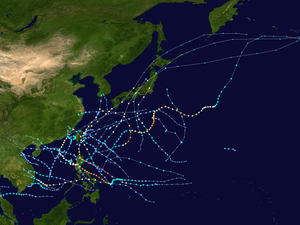
Back Pazifische Taifunsaison 1998 German Saison cyclonique 1998 dans l'océan Pacifique nord-ouest French 1998年の台風 Japanese 1998년 태풍 Korean Tyfoonseizoen van de Grote Oceaan 1998 Dutch Temporada de tufões no Pacífico de 1998 Portuguese Mùa bão Tây Bắc Thái Bình Dương 1998 Vietnamese 1998年太平洋颱風季 Chinese
This page is currently being merged. After a discussion, consensus to merge this page with Typhoon Rex was found. You can help implement the merge by following the instructions at Help:Merging and the resolution on the discussion. Process started in November 2024. |
| 1998 Pacific typhoon season | |
|---|---|
 Season summary map | |
| Seasonal boundaries | |
| First system formed | May 28, 1998 |
| Last system dissipated | December 21, 1998 |
| Strongest storm | |
| Name | Zeb |
| • Maximum winds | 205 km/h (125 mph) (10-minute sustained) |
| • Lowest pressure | 900 hPa (mbar) |
| Seasonal statistics | |
| Total depressions | 31, 2 unofficial |
| Total storms | 16 |
| Typhoons | 8 |
| Super typhoons | 3 (unofficial) |
| Total fatalities | 924 total |
| Total damage | $950.8 million (1998 USD) |
| Related articles | |
The 1998 Pacific typhoon season was the least active Pacific typhoon season on record, until it was surpassed 12 years later. It would produce 16 tropical storms, 8 strengthening into typhoons.[1] The scope of this article is limited to the Pacific Ocean, north of the equator and west of the International Date Line. Storms that form east of the date line and north of the equator are called hurricanes; see 1998 Pacific hurricane season. Tropical Storms formed in the entire west Pacific basin were assigned a name by the Joint Typhoon Warning Center. Tropical depressions in this basin have the "W" suffix added to their number. Tropical depressions that enter or form in the Philippine area of responsibility are assigned a name by the Philippine Atmospheric, Geophysical and Astronomical Services Administration or PAGASA. This can often result in the same storm having two names.
The 1998 season was very weak compared to the 1997 season; this was due to the strong El Niño in the previous season. During the 1998 season, a total of 28 tropical depressions developed across the western Pacific basin. Of those 28 depressions, a total of 18 strengthened into tropical storms of which 9 further intensified into typhoons. The first tropical cyclone developed on May 28, marking the fourth latest start to any Pacific typhoon season on record, and the last one dissipated on December 22. The Philippine region also set a record: with only eleven storms forming or moving into its area of responsibility, PAGASA had its quietest season on record, later tying with the 2010 and 2023 seasons. Overall inactivity was caused by an unusually strong La Niña, which also fueled a hyperactive Atlantic hurricane season that year.
- ^ "Gary Padgett's Monthly Global Tropical Cyclone Summary". www.typhoon2000.ph. Archived from the original on November 30, 2010.